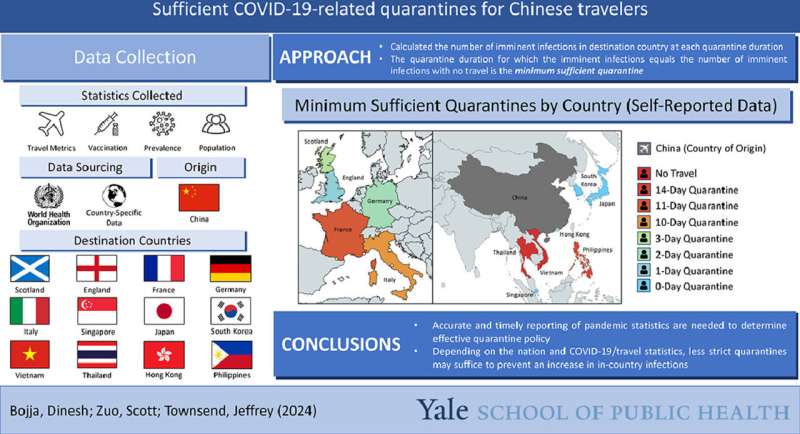This article has been reviewed according to Science X's editorial process and policies. Editors have highlighted the following attributes while ensuring the content's credibility:
fact-checked
peer-reviewed publication
trusted source
proofread
To avoid infection spread, how long a quarantine is sufficient? It depends

In December 2022, China lifted the stringent COVID-19 restrictions it had imposed early in the pandemic, and infections throughout the country rapidly increased. In response, some countries restricted travelers from China in an effort to prevent increases in their own infection rates.
But a new Yale study finds that such strict border controls may not have been necessary for many countries.
For the study, published in the International Journal of Infectious Diseases, researchers used national demographics from more than a dozen nations, COVID-19 infection rates, and travel data to determine how many days of quarantine would have been necessary to keep a country's infection rates at the same level they would experience under total border closure.
They found that the optimal quarantine lengths varied significantly from country to country, with some requiring just a few days and others benefitting from complete border closure.
"The idea behind quarantine is to keep a disease from entering your country," said Jeffrey Townsend, the Elihu Professor of Biostatistics at Yale School of Public Health and senior author of the study.
"And it's incredibly effective when used that way. But during the COVID-19 pandemic, quarantines were being used by countries that already had infection spread. That makes its effectiveness more complicated. It's worth knowing how to best apply quarantine so you don't unnecessarily overuse resources to implement it."
Consider the unlikely scenario in which two countries have the same populations, rates of infection and immunity, and number of travelers between each other. In that case, both countries would, on average, bring in the same number of infected travelers as they sent out, and their internal infections would remain largely unaffected by international travel between the two nations, Townsend explained.
In reality, those factors wouldn't be the same between two countries, said Townsend. The approach developed by the researchers uses the real-world numbers for those factors to determine the minimum amount of quarantine time necessary to keep international travel from increasing a country's COVID-19 infection rates in any meaningful way.
The study calculated quarantine lengths that were sufficient to prevent additional new COVID-19 infections caused by international travelers between China and 12 other countries from Feb. 13 through Feb. 19, 2023.
Scotland was among the countries that would have benefitted from shorter quarantine times—three days—driven largely by Scotland's small number of daily travelers from China (226 people).
On the other hand, countries with higher immunity and lower prevalence of COVID-19 in their populations—such as France—needed 13-day quarantines to prevent any increase in infections. A large number of infected people arriving from China would significantly add to the infection tally in a country where widespread immunity had lowered infection rates, researchers said.
At the most extreme ends were countries that needed no quarantine, such as Singapore, South Korea, and Japan. These countries already had high prevalence of COVID-19, meaning new infections would have little effect. Countries that needed complete border closure—including Vietnam and Thailand—had very low infection rates that would rise with an influx of infected travelers.
"The beauty of this model is its accessibility and broad generalizability in unique pandemic situations," said Dinesh Bojja '26, a student researcher in Townsend's lab and lead author of the study. "Regardless of the location, virus, or stage of pandemic, policymakers can easily determine what level of quarantine to impose to protect their citizens—making it incredibly powerful as a preventative tool in future pandemic responses."
This approach is most effective when countries provide accurate and timely data on infection rates, said the researchers. And the findings, they added, emphasize how evidence-based decision-making yields more effective policies that better benefit public health.
"Pandemic responses are health decisions and cost decisions, and this approach identifies what actions are sufficient to achieve the best health protections," said Townsend. "Public health and pandemic preparedness offices should have this model, which is available for them to use, at the ready to advise politicians on what to do."
More information: Dinesh Bojja et al, Sufficient COVID-19 quarantine and testing on international travelers to forestall cross-border transmission after China's removal of the Zero-COVID policy in early 2023, International Journal of Infectious Diseases (2024). DOI: 10.1016/j.ijid.2024.107097




















